Do you have a question about the Mastervolt MASS COMBI 12/2500-100 and is the answer not in the manual?
Guideline for safe and effective operation and maintenance of the Mass Combi.
Details on product warranty, coverage, and limitations.
Copyright, reproduction rights, and applicability to standard versions.
Information on unit testing and standard guarantee period.
Mastervolt's limitations of liability for damage and errors.
Location and importance of the unit's identification label.
Conditions for making modifications to the Mass Combi unit.
Explanation of pictograms used for safety instructions and warnings.
Specifies the approved applications and limitations for the Mass Combi.
User responsibilities including manual access and familiarity.
Procedures for safe maintenance and the use of original spare parts.
Critical safety rules for installation and operation to prevent hazards.
Restrictions on using the product in life support systems.
Hazards associated with battery discharge and charging, and proper installation.
Details the electronic control and three-stage charging method (Bulk, Absorption, Float).
Explains the stages of battery charging and automatic switching.
How battery temperature affects charge voltage for optimal performance.
Instructions for connecting a secondary battery for maintenance charge.
Functionality of the inverter providing regulated AC power from batteries.
Inverter capabilities, protection features, and energy efficiency.
Features to reduce battery consumption when the inverter is unloaded.
Overview of different operational modes and their features.
Describes inverter mode when no external AC is available.
Explains the two AC outputs: SHORT BREAK and POWER.
Feature to reduce charger output to prevent AC input overload.
Adds inverter power to AC outputs when AC input is insufficient.
Alternative to Generator/Mains support for increasing AC output power.
Table summarizing AC operation modes and their DIP-switch settings.
How to connect two units to double inverter and charge power.
Options for monitoring and controlling the Mass Combi remotely.
Details of the Inverter Charger Control (ICC) remote panel.
Details of the AC Power Control (APC) remote panel for power sharing.
Advanced digital remote panel with additional monitoring features.
Interface for connecting the Mass Combi to a MasterBus network.
Information on alarm contacts and their functionality with voltage thresholds.
Explanation of LED indicators on the front panel for status and failures.
Procedures for turning the Mass Combi on and off using the main switch.
Steps to power up the unit and its initial behavior.
How to safely power down the Mass Combi.
Setting to operate only as a charger, useful for battery maintenance.
Overview of internal protections against overload, short circuit, etc.
Details on the thermal fuse protection for the transfer switch.
How the unit reacts to output overloads or short circuits.
Causes and behavior of the unit during overheating.
Protection mechanisms for AC and DC input voltage variations.
Simple maintenance requirements for the Mass Combi.
Guidance on where to find solutions for issues.
Steps for unpacking and checking the product contents.
Environmental conditions and mounting stipulations for installation.
General wiring instructions and AC wiring considerations.
Guidelines for selecting wire cross-sections and colors for AC connections.
Instructions for DC cable connections, wire sizes, and color coding.
Procedures for ensuring proper AC safety grounding and neutral connection.
List of required components and tools for installation.
Steps for safely removing the front panel.
Diagram and labels for the connection compartment.
Step-by-step instructions for mounting the unit cabinet.
General warnings and notes before starting wiring.
Detailed wiring steps for a single unit installation.
Detailed wiring steps for parallel installation of two units.
Description of alarm contacts and their terminal assignments.
Introduction to DIP-switch settings for configuration.
Configuration settings using DIP Switch A.
Setting DIP switches for Master/Slave configuration.
Setting the output frequency for the inverter.
Adjusting energy saving features for different operating modes.
Setting the correct battery type for optimal charging.
Configuration of the ground relay for inverter operation.
Configuration settings using DIP Switch B.
Setting DIP switches to limit AC input current.
Enabling the Power Support feature.
Enabling the Generator/Mains support feature.
Adjusting frequency window for AC input with distorted waveform.
Remote control functionality based on DIP switch settings.
Instructions and warnings for using the equalize charging mode.
Steps to follow for initial setup and activation of the Mass Combi.
Procedures for safely taking the Mass Combi out of operation.
Introduction to the MasterBus data network and its benefits.
Rules and guidelines for establishing a MasterBus network connection.
Overview of monitoring and configuring the Mass Combi via MasterBus.
Parameters available for monitoring the Mass Combi's status.
Parameters that can be configured via MasterBus network.
List of event sources that can initiate commands on the MasterBus.
List of event commands and data for initiating actions on MasterBus devices.
Explanation of LEDs indicating failures and their causes.
How to determine the software version using front panel LEDs.
Detailed technical specifications for the inverter function.
Detailed technical specifications for the charger function.
Miscellaneous technical data including switch system and environmental specs.
Guideline for safe and effective operation and maintenance of the Mass Combi.
Details on product warranty, coverage, and limitations.
Copyright, reproduction rights, and applicability to standard versions.
Information on unit testing and standard guarantee period.
Mastervolt's limitations of liability for damage and errors.
Location and importance of the unit's identification label.
Conditions for making modifications to the Mass Combi unit.
Explanation of pictograms used for safety instructions and warnings.
Specifies the approved applications and limitations for the Mass Combi.
User responsibilities including manual access and familiarity.
Procedures for safe maintenance and the use of original spare parts.
Critical safety rules for installation and operation to prevent hazards.
Restrictions on using the product in life support systems.
Hazards associated with battery discharge and charging, and proper installation.
Details the electronic control and three-stage charging method (Bulk, Absorption, Float).
Explains the stages of battery charging and automatic switching.
How battery temperature affects charge voltage for optimal performance.
Instructions for connecting a secondary battery for maintenance charge.
Functionality of the inverter providing regulated AC power from batteries.
Inverter capabilities, protection features, and energy efficiency.
Features to reduce battery consumption when the inverter is unloaded.
Overview of different operational modes and their features.
Describes inverter mode when no external AC is available.
Explains the two AC outputs: SHORT BREAK and POWER.
Feature to reduce charger output to prevent AC input overload.
Adds inverter power to AC outputs when AC input is insufficient.
Alternative to Generator/Mains support for increasing AC output power.
Table summarizing AC operation modes and their DIP-switch settings.
How to connect two units to double inverter and charge power.
Options for monitoring and controlling the Mass Combi remotely.
Details of the Inverter Charger Control (ICC) remote panel.
Details of the AC Power Control (APC) remote panel for power sharing.
Advanced digital remote panel with additional monitoring features.
Interface for connecting the Mass Combi to a MasterBus network.
Information on alarm contacts and their functionality with voltage thresholds.
Explanation of LED indicators on the front panel for status and failures.
Procedures for turning the Mass Combi on and off using the main switch.
Steps to power up the unit and its initial behavior.
How to safely power down the Mass Combi.
Setting to operate only as a charger, useful for battery maintenance.
Overview of internal protections against overload, short circuit, etc.
Details on the thermal fuse protection for the transfer switch.
How the unit reacts to output overloads or short circuits.
Causes and behavior of the unit during overheating.
Protection mechanisms for AC and DC input voltage variations.
Simple maintenance requirements for the Mass Combi.
Guidance on where to find solutions for issues.
Steps for unpacking and checking the product contents.
Environmental conditions and mounting stipulations for installation.
General wiring instructions and AC wiring considerations.
Guidelines for selecting wire cross-sections and colors for AC connections.
Instructions for DC cable connections, wire sizes, and color coding.
Procedures for ensuring proper AC safety grounding and neutral connection.
List of required components and tools for installation.
Steps for safely removing the front panel.
Diagram and labels for the connection compartment.
Step-by-step instructions for mounting the unit cabinet.
General warnings and notes before starting wiring.
Detailed wiring steps for a single unit installation.
Detailed wiring steps for parallel installation of two units.
Description of alarm contacts and their terminal assignments.
Introduction to DIP-switch settings for configuration.
Configuration settings using DIP Switch A.
Setting DIP switches for Master/Slave configuration.
Setting the output frequency for the inverter.
Adjusting energy saving features for different operating modes.
Setting the correct battery type for optimal charging.
Configuration of the ground relay for inverter operation.
Configuration settings using DIP Switch B.
Setting DIP switches to limit AC input current.
Enabling the Power Support feature.
Enabling the Generator/Mains support feature.
Adjusting frequency window for AC input with distorted waveform.
Remote control functionality based on DIP switch settings.
Instructions and warnings for using the equalize charging mode.
Steps to follow for initial setup and activation of the Mass Combi.
Procedures for safely taking the Mass Combi out of operation.
Introduction to the MasterBus data network and its benefits.
Rules and guidelines for establishing a MasterBus network connection.
Overview of monitoring and configuring the Mass Combi via MasterBus.
Parameters available for monitoring the Mass Combi's status.
Parameters that can be configured via MasterBus network.
List of event sources that can initiate commands on the MasterBus.
List of event commands and data for initiating actions on MasterBus devices.
Explanation of LEDs indicating failures and their causes.
How to determine the software version using front panel LEDs.
Detailed technical specifications for the inverter function.
Detailed technical specifications for the charger function.
Miscellaneous technical data including switch system and environmental specs.
| Brand | Mastervolt |
|---|---|
| Model | MASS COMBI 12/2500-100 |
| Category | Inverter |
| Language | English |
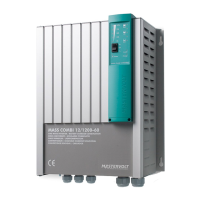
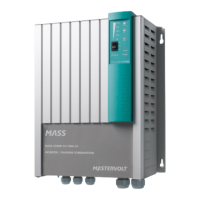
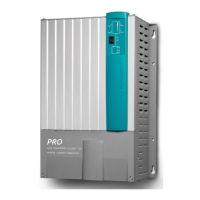
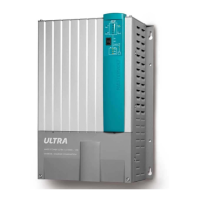


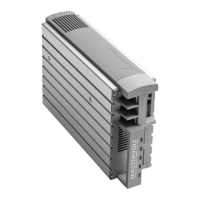
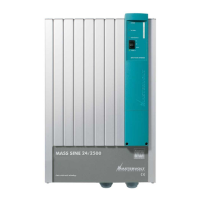
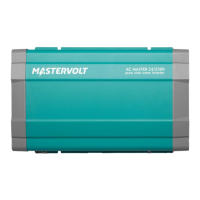

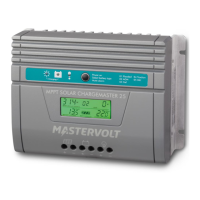
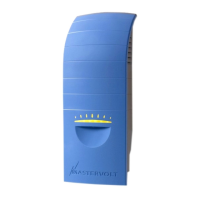
